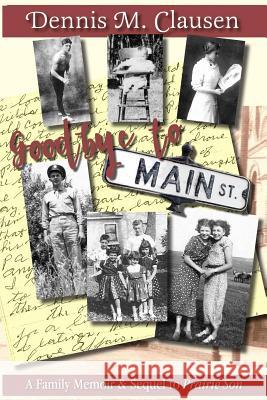Goodbye to Main Street: A Family Memoir & Sequel to Prairie Son » książka
Goodbye to Main Street: A Family Memoir & Sequel to Prairie Son
ISBN-13: 9781539503156 / Angielski / Miękka / 2016 / 452 str.
Dennis M. Clausen's Prairie Son (1999), recipient of the 1997 First Series Award for Creative Nonfiction, explored his father Lloyd Clausen's early life after a farm family adopted him in 1922 to be a worker and not a son. Prairie Son was nominated for several national literary awards and was voted one of the five best books published in 1999 by a University of Minnesota graduate. The St. Paul Pioneer Press wrote, "Have you ever read a book so good you don't want it to end? Prairie Son will make you feel that way." Publisher's Weekly described Prairie Son as "an archetypal account of Depression-era hardship," and Foreword Magazine described the book as "Truly memorable. Outstanding." After Prairie Son was published, Clausen received letters from members of other families who experienced similar adoptions in their histories. While interacting with these families, Clausen realized the practice of adopting children to be workers was far more common than he had previously thought. Like Clausen's father, these children who were adopted to be workers in their adoptive homes often struggled later in life with relationships and feelings of never truly belonging anywhere. GOODBYE TO MAIN STREET, a family memoir and sequel to Prairie Son, is one journey divided into two major parts. The first half of Goodbye to Main Street is set in the small prairie town where the author grew up. It depicts the lives of his original family in the middle of the last century after his parents were divorced. It also describes how his father Lloyd Clausen struggled with relationships and wandered into and out of his life, seemingly "still searching for a place where he fit in." His father seemed to be deeply troubled by things that happened to him earlier in his life, but was reluctant to talk about them. Whatever they were, they appeared to have hurt him too deeply to share those secrets. The second half of Goodbye to Main Street is triggered by family mysteries connected to the legacy of previous generations. These mysteries motivated Clausen to complete his father's journey by researching and connecting with Lloyd's biological family. Clausen eventually located the brother of his father's birth mother. Later, he was contacted by Lloyd's half-sister, who was unaware that she had a brother who had been given up for adoption. Clausen also connected with Lloyd's biological father's family who, it turned out, were actually looking for the "uncle" they had heard about, but never met. Eventually, Clausen and his family were invited to a reunion of descendants of Lloyd's biological father's family. At the reunion, he learned important details regarding the events that created an out-of-wedlock pregnancy and the birth of the child (his father) who had three different names before he was one-year old. Through these sources, Clausen began to find answers to the many unanswered questions in his family history. Who was his biological grandfather, the man he only knew through an ancient, faded photograph of a young man in a wrestling pose? Why did his biological grandmother keep her child (his father) hidden on the family farm for several months before giving him up for adoption? Was the mysterious "Aunt" Delores, another adopted child and his father's most enduring love, on a mission later in life to resurrect his reputation in the eyes of his children? Was his father's failure to develop lasting relationships the result of his early childhood experiences in his adoptive parents' home? By researching and connecting with his biological relatives who shared the same ancestral "roots," Clausen completed his father's journey by exposing the actions of previous generations that had shaped his family history.
Zawartość książki może nie spełniać oczekiwań – reklamacje nie obejmują treści, która mogła nie być redakcyjnie ani merytorycznie opracowana.











